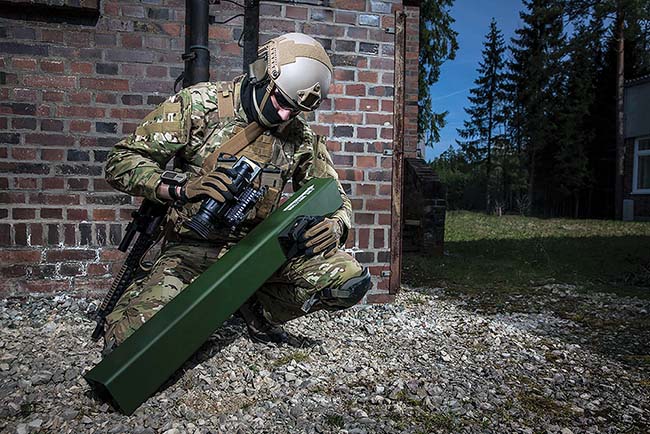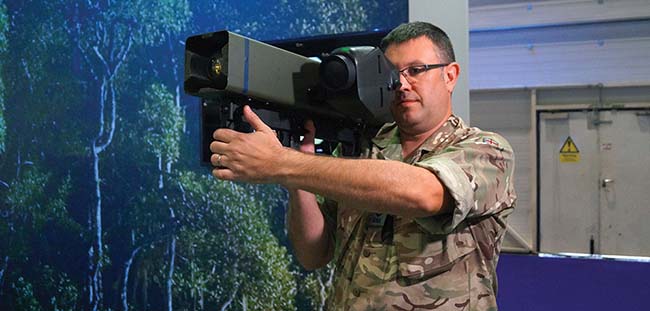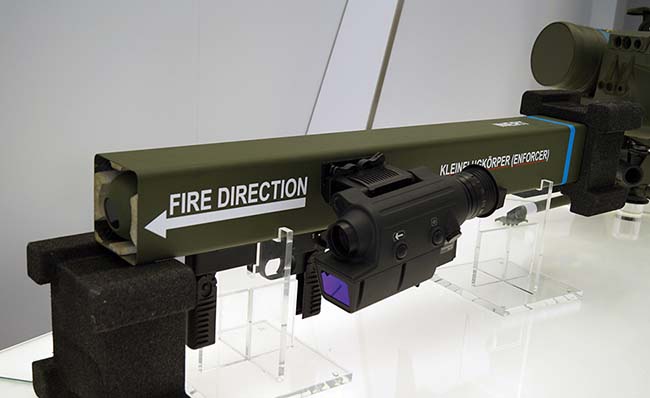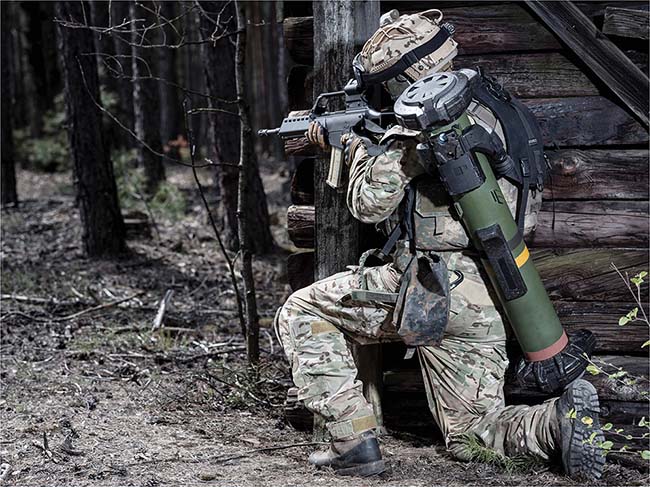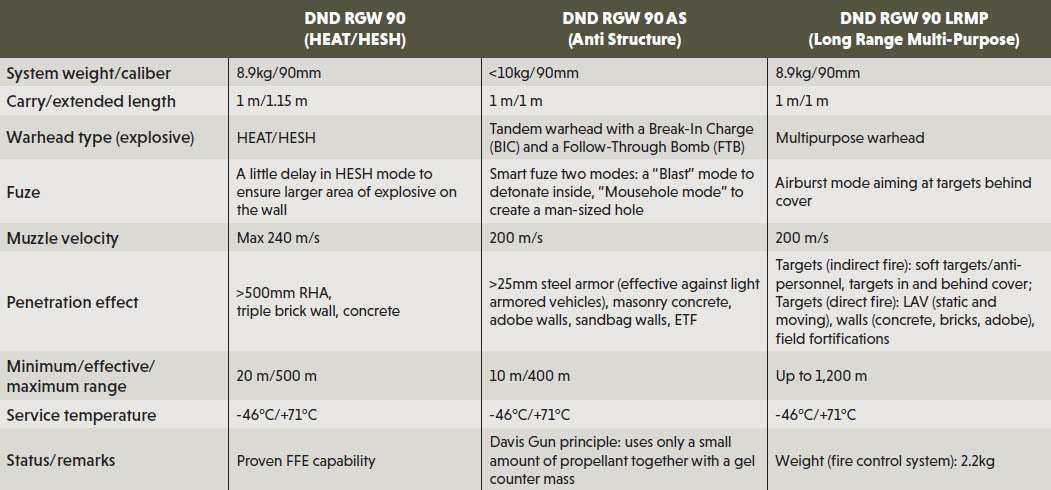ABOVE: The RGW 90 LRMP (Long Range Multi-Purpose) is a lightweight weapon with a programmable warhead fuze, which is very effective against a variety of targets and has an effective range of 1,200 meters. (Dynamit Nobel Defence GmbH)
Part Two described some unguided, shoulder-launched rocket weapons. Among these was the Panzerfaust 3 family produced by Dynamit Nobel Defence (DND) from Germany. Such shoulder-launched anti-tank weapons have turned into versatile multipurpose weapons, and new developments are ongoing. The purpose of this article is to describe the following products:
DND’s shoulder-launched Recoilless Grenade Weapon (RGW) 90 with multipurpose capabilities;
MBDA’s shoulder-launched Enforcer guided missile system;
Rafael’s shoulder-launched Spike SR (Short Range) infantry missile;
Javelin.
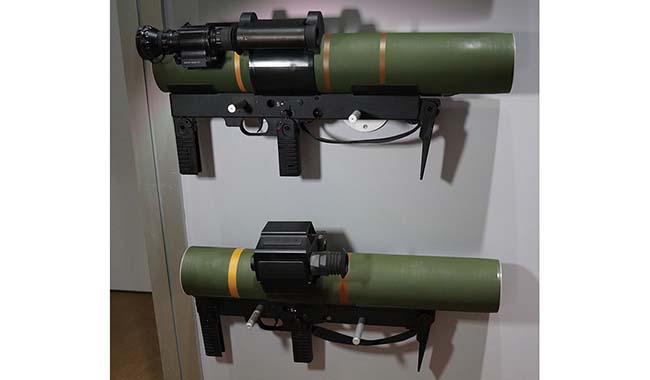
RGW 90
DDND GmbH has developed a new shoulder-launched weapon: the RGW 90. It’s designed to fill the gap between current shoulder-fired weapons that are capable of operating at ranges of 300–600 meters and anti-tank missiles.
The RGW 90 LRMP is a 90mm man-portable, anti-armor, multipurpose disposable weapon system. RGW is short for “Recoilless Grenade Weapon,” while LRMP describes the “Long Range Multi-Purpose” nature of the programmable warhead. It’s fully mechanical, has no power supply, recoilless and easy to handle. The RGW 90 LRMP has an effective range of 1,200 meters and is very effective against a variety of targets. The Dynahawk reusable fire control sight maximizes the first hit probability against distant targets by allowing the gunner to measure target distance and other relevant data in the visual field. The warhead, which utilizes a trimodal programmable warhead fuze, can be set before firing by the shooter for point (impact), short or delay activation—enabling the weapon to defeat light armored vehicles and field fortifications—or it can be set for airburst to defeat targets behind cover. The effector is a 90mm multifunctional warhead with an effective range from very short (20 meters) up to 1,200 meters, double the effective combat range of comparable weapons. Like other Dynamit Nobel Defence weapons, the RGW 90 LRMP is operable from enclosed/confined spaces, which is particularly useful for combat engagements in urban terrain. Thanks to its state-of-the-art in-flight propulsion system, the RGW 90 has an excellent hit probability. A standard interface rail allows a night sight to be fitted. The weapon can also be delivered with an illuminated sight to provide night fighting capability without the need for additional accessories. Featuring a non-electric firing circuit and several independent safety elements in the firing mechanism, the RGW 90 LRMP is safe to ship and handle under all environmental conditions. Its high-quality optical sight and balanced, ergonomic design help to increase the weapon’s effectiveness. A complete set of training equipment is also available for the RGW 90. The RGW 90 LRMP fulfills many of the tactical requirements of infantry units for a truly multipurpose tactical weapon. Procurement of the RGW 90 LRMP from Dynamit Nobel Defence began with the German KSK (Kommando Spezialkräfte) and Naval Special Forces. The infantry will subsequently be equipped.
The RGW 90 AS (Anti Structure) is specially designed to support troops in an urban environment. The tandem warhead with a Break-In Charge (BIC) and a Follow-Through Bomb (FTB) performs well against a variety of structures. The smart fuze of the FTB allows the gunner to choose between two modes: a “Blast” mode to detonate inside the building to remove its protective value and a “Mousehole” mode to create to create a man-sized hole. The high level of penetration offered by the combined BIC and FTB warhead also provides excellent performance against light armored vehicles.
The RGW 90 HH is a lightweight multipurpose weapon, capable of defeating tanks as the primary target and buildings or field fortifications as the secondary target. With its 90mm dual-mode warhead, the RGW 90 provides all these capabilities in a single, lightweight, disposable weapon at an affordable cost. RGW 90 features an excellent hit probability due to a state-of-the-art in-flight propulsion system and can be Fired From Enclosure (FFE).
MBDA Enforcer
Enforcer is a German-led, multinational MBDA program with the aim of providing a simple, quick and effective protection weapon for soldiers in action against a variety of threats. Enforcer is the answer to the need for a lightweight and high-precision weapon with standoff capability for infantry and Special Forces at an affordable cost. The Enforcer concept is a new, lightweight, disposable shoulder-launched guided munition in the 2,000-meter range class with high precision over the full range. Enforcer provides major advantages for infantry and Special Forces, bringing with it superior range and effect compared to heavy machine guns, Grenade Machine Guns and rocket launchers. Compared to previously used weapons systems, this small missile offers numerous advantages. It’s a lock-on-before-launch (LOBL) and fire-and-forget missile system with minimal exposure of the operator to enemy fire. Enforcer can be operated from behind cover and from enclosed/confined spaces. The weapon can be carried and operated by a single soldier (missile + launch tube <9kg). The system (sight and two munitions) weighs <20kg, and the missile weighs <7kg. It enables dismounted infantry to engage lightly protected battlefield and urban targets at relevant combat ranges beyond the capability of currently available infantry weapons. Enforcer can be used to engage a broad variety of targets, including lightly armored, static and moving targets, threats behind cover, soft-skinned targets (including concealed snipers) and infrastructure, with high precision and minimal collateral damage. The missile is effective against targets behind cover through its airburst capability, multi-effects warhead and ability to be fired from enclosed spaces. Enforcer has already demonstrated its technical maturity in several tests to prove the viability of the technology and design. Successful firing against moving targets and airburst trials at a range of 1,000 meters in 2017 followed three successful guided firing trials in November 2016. These demonstrations were carried out with a development model of the Enforcer at the Bundeswehr’s Technical Center for Weapons and Ammunition against stationary targets at ranges between 1,000 meters and 2,000 meters, using both an earlier steel launch tube and the new developmental carbon fiber tube. The firings were part of the proving trials for the missile’s LOBL EO homing guidance and also demonstrated a new, much lower flight trajectory in the missile engagement sequence and very high precision at all ranges. Data analysis of the firing confirmed that the seeker precisely detected and tracked the target for the entire flight of the missile. One of the areas MBDA is currently working on is the Bundeswehr’s night fighting capability requirement. MBDA plans to begin qualification and series production of this very compact missile over the next few years. In this respect, more guided firings are planned for 2018. Enforcer will be offered to the German Army. It will also be available in 90mm caliber, which could complement the RGW 90 LRMP infantry weapon. Enforcer’s modular architecture enables a range of future development options—preempting the anticipated evolution of military operations scenarios toward greater complexity—including the prospect of an Enforcer munitions family. Another advantage of the missile’s modular design is its potential for customization for different applications and platforms.
Spike SR (Short Range)
A short-range, man-portable, shoulder-fired, fire-and-forget, electro-optical (EO) guided missile, Spike SR is the latest and most compact member of Rafael’s fourth- and fifth-generation Spike missile family.
The Spike family comprises such electro-optical missile systems as the Spike MR/LR (Medium Range/Long Range—maximum range 2.5 kilometers/4 kilometers), Spike ER (Extended Range—8 kilometers) and the standoff Spike NLOS (Non Line Of Sight—30 kilometers). The whole Spike family is operated by 29 nations, which have procured more than 29,000 missiles in the last 25 years. In addition, Rafael has unveiled the new Spike LR II missile (5.5-kilometer range) to meet today’s new operational requirements. Spike SR is optimized to defeat modern MBTs and APCs and to penetrate bunkers. It was designed as a very light multipurpose infantry weapon for use by the infantry platoon, infantry squad or Special Operations Forces. Unlike the aforementioned shoulder-launched rocket system RGW 90, Spike SR is a guided missile. The SR missile was tailored to the combat needs of infantry forces in contemporary and future conflicts. It is optimal for use in a large variety of operational and environmental scenarios against a range of conventional threats (including regular forces using established tactics) and unconventional threats (such as insurgents employing asymmetric tactics) worldwide. Spike SR is simple to use; the operation sequence involves four switches and responsive icons, as it was designed for the basic infantry. Spike SR has a short time interval from power-up to operational readiness. In less than six seconds the missile is ready to engage targets that are exposed only for brief periods. Unlike the gimballed seeker installed in the Spike MR/LR/ER (Medium-Range/Long Range/Extended Range) missiles, the Spike SR incorporates an uncooled and fixed dual day/night-capable EO seeker and tracker that offers lock-on and fire-and-forget capabilities against even fast-moving targets.
The Spike SR has a high hit probability against stationary and moving targets from 50 meters out to 1,500 meters. The short minimum range of only 50 meters came as an operational requirement from the multiple customers of the Spike family in NATO. Such a short-range capability could become important in forested battle arenas, where a tank target can appear suddenly between the trees.
The Spike SR missile launcher includes an embedded miniature Command Launch Unit (CLU) that, like the canister, is totally disposable after launch. This means there’s nothing to maintain, driving the LCC down. All the capabilities mentioned above are packed into a small (98-centimeter) and light package weighing a little less than 10kg (including the missile, CLU and battery). Spike SR’s operational simplicity provides the infantry soldier with the versatility and rapid response capabilities that are essential in modern conventional and asymmetric combat. The Spike SR was designed to give the infantry a low-cost, high-end solution, capable of destroying MBTs, as well as other targets, at less than half the price of modern ATGMs. The Spike SR has already been procured by several customers and is an off-the-shelf product.
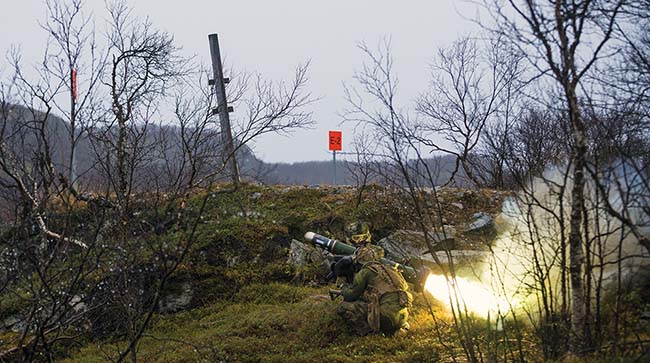
Javelin
Javelin is a shoulder-fired, fire-and-forget, portable anti-tank missile. The missile system is most often carried by a two-person team consisting of a gunner and an ammunition bearer, although it can be fired with just one person if necessary. While the gunner aims and fires the missile, the ammo bearer scans for prospective targets, watches for threats, such as enemy vehicles and troops and ensures that personnel and obstacles are clear of the missile’s backblast.
To fire, the gunner places a cursor over the selected target. The Javelin CLU then sends an LOBL signal to the missile. With its soft-launch design, Javelin can be safely fired from inside buildings or bunkers. The missile is ejected from the launcher so that it reaches a safe distance from the operator before the main rocket motor ignites: a “soft launch” arrangement. This makes it harder to identify the launcher; however, backblast from the launch tube still poses a hazard to nearby personnel. Javelin’s long-wave IR seeker enables it to engage under conditions of reduced visibility and resist countermeasures. The team can reposition immediately after firing or prepare to fire on their next target while the first missile is still in the air. The system takes a top-attack flight profile against armored vehicles (attacking the top armor, which is generally thinner), but can use a direct-attack mode against buildings, targets inside the minimum top-attack engagement range and targets under obstructions. Javelin is combat proven, used by American forces in the Iraq War and in Afghanistan. In Afghanistan, American soldiers also used the Javelin against threatening insurgents firing from machine gun positions. Its versatility makes it effective against tanks, bunkers, buildings, small boats and slow-moving helicopters in the direct-attack mode. It can reach a peak altitude of 150 meters (500 feet) in top-attack mode and 60 meters (190 feet) in direct-attack mode. The tandem warhead is fitted with two shaped charges: a precursor warhead to detonate any explosive reactive armor and a primary warhead to penetrate base armor. Javelin has a wide range of effectiveness (from less than 75 meters to more than 2,500 meters), offers more tactical possibilities and has unmatched lethality; with a missile reliability level of more than 93%, its first-hit probability is over 94%. The Javelin system is adaptable to many platforms, including tripods, trucks, light armored vehicles and remotely piloted vehicles. Javelin is sold in Europe, the Pacific and the Middle East.
